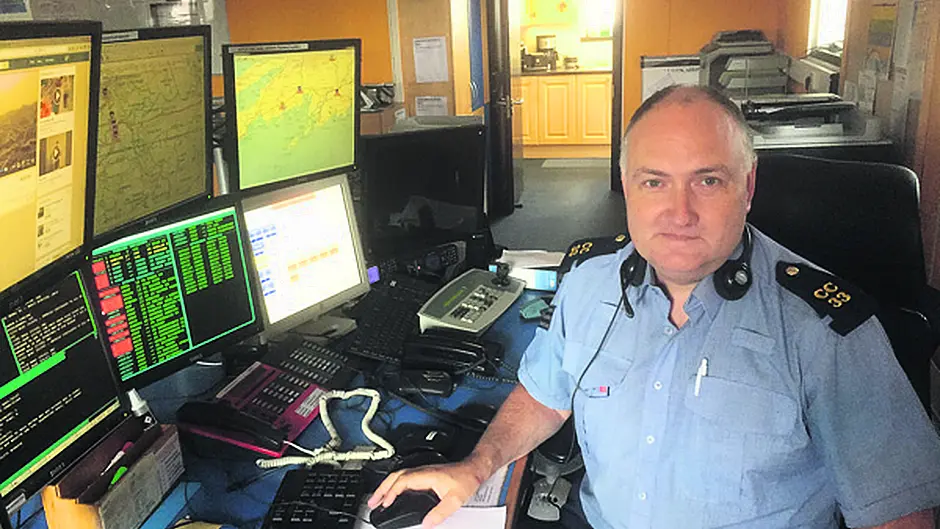Reporter Kieran O'Mahony spends a day in the Anglesea Street Communications Centre of An Garda Síochána to find out what happens when that crisis call comes in
Reporter Kieran O’Mahony spends a day in the Anglesea Street Communications Centre of An Garda Síochána to find out what happens when that crisis call comes in
EVER wonder where your 999 call ends up when you ask for the gardaí?
Anglesea Street Communications Centre is the hub of all emergency garda activity for Cork and Kerry and it was working overtime for the past few days, fielding Ophelia calls from both counties.
With a full-time staff of seven, it covers a geographical area with a population of 800,000, excluding tourists.
Sgt Peter Murphy is the Emergency Response Co-ordinator who, along with his team, are based in a room on the top floor of the busy Cork city garda station.
Walls of computer screens are backed up with 42 CCTV screens for the team that handles all 112 and 999 emergency calls both counties.
‘This place acts as a hub for the whole city and county – we’re the only control centre based in Cork,’ explained Sgt Murphy.
‘It doesn’t matter to us if our customer is a mile out the road, or at the end of the Beara peninsula, they’ll be entitled to the same service and the same level of professionalism.’
Dealing with numerous agencies is all part of their job and these include the fire service, national ambulance, Irish Coastguard, as well as voluntary agencies such as Civil Defence and Mountain Rescue.
They also have 15 special sites in their area of responsibility.
These include major pharmaceutical plants including Pfizer, Novartis and Eli Lilly and the centre holds maps and all essential details of each company in the event of an emergency.
‘The Communications Centre is divided into two functional areas. It’s call-taking facility, which takes all the emergency calls for Cork city and county, including all your direct calls from ambulances and fire services.
Then there’s a bank of CCTV cameras in the other room and they’re monitored, particularly when there’s an event going on, which gives us unparalleled coverage of the city centre and a lot of the approaches.’ With an operation covering such a wide area, technology is of course at the heart of the operation and Tetra digital communications technology is used, as well as digital maps.
‘All of our calls received are logged in our CAD (Computer Aided Despatch) system, and each is automatically given a generated unique incident number and that number stays with it all of the time throughout the process of managing the call, whether the call is held on to, or whether it’s dispatched, re-opened or reviewed down the line.’
When the gardaí or emergency services arrive on the scene of an incident, they’ll have more information and so the team keeps building its response and then sends out further updates. ‘So it’s gone now from a very basic call to something that has expanded much more and that would be the same principle we use for all of the incidents we get reports on,’ added Sgt Murphy.
Maps play a key role in the operation and they are, according to Sgt Murphy, a vital tool.
‘If we have any incident at all, we use simple basic special maps that were made up by the Garda Mapping Section.
‘They show where everything is in different scales, and we use them when we’re planning things, or if a road or route is causing an issue. I’m a big believer in maps and mapping, as they cut out a lot of lack of misunderstanding and ambiguity. The other response agencies all use the same maps.’
They also have separate sheets for critical infrastructures such as Cork Airport, the Port of Cork and the Jack Lynch Tunnel, in the event of any incident occurring.
With Cork county being so large, it often means that several serious or critical incidents could be going on simultaneously, which requires a lot of composure.
‘We are trained and equipped to deal with this type of “call compression” and while we can sometimes be quite stretched, we always work to provide the best service that we can for our own members and for the whole community.’
Sgt Murphy highlighted the severe weather and flooding that has hit the county in recent years and said that these incidents need ‘robust command and control procedures’ as well as solid
inter-agency co-operation.
‘No two situations are ever the same, and we have to constantly re-evaluate and re-assess our operational imperatives in response to dynamic and rapidly changing environments.’
The sound proofing in the operations room is to the same standard as that used in a recording studio, and is designed to reduce the noise footprint.
‘It’s a much quieter footprint here and everything is done with headsets, so even if there’s a panic going on, or a big incident, it should remain calm here.
‘It’s very important that you have the right type of people working here and the right type of people in charge.’








